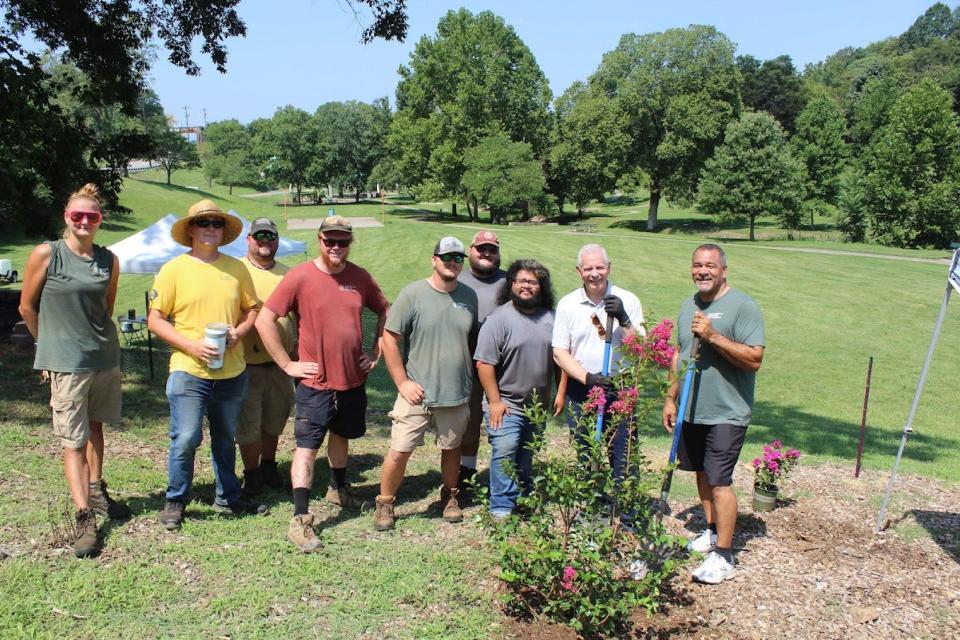Bees, butterflies and hummingbirds welcomed to Valleybrook Park
Sarah Birk has been leading a focused effort to make the city of Clarksville’s already-beautiful Valleybrook Park off of Crossland Avenue even more eye-catching for the public, and at the same time, more functional and attractive to beneficial bees, butterflies, and other essential pollinators in the regional wildlife kingdom.
Seeing this season’s final plantings of various flowering bushes and other species that attract pollinators was a rewarding moment for Birk, a Grounds and Facilities Maintenance Technician for Clarksville Parks & Recreation.

“It’s amazing, and I’m really excited for the upcoming years, to see it all grow and thrive and get bigger to add beauty to this already-wonderful park, and support a greater influx of pollinators,” Birk said. “But really, everybody working together to make this happen has been probably the best part. We hope everyone will come enjoy it.”
Clarksville Mayor Joe Pitts got in on the action, planting a red-blooming Crepe Myrtle, rich orange- and- yellow-blooming Lantanas, and other plants that support the goal.
“This is very rewarding to see, and participate in,” Mayor Pitts said. “We have here, a beautiful spot on this hillside overlooking historic Valleybrook Park, that has been set aside for this pollinator garden.
“Sarah Birk and the whole crew have done a great job, picking out a spot, manicuring it and getting it ready, and I think the public, as they use this park, will be pleased,” he said.
Jennifer Letourneau, Director of Clarksville Parks & Recreation, added that her departmental staff has done a “phenomenal job” with accentuating all that Valleybrook Park can become.
“In particular, Sarah Birk invested a lot of research in the project, and she and Randy Kelly (Clarksville Parks & Rec Deputy Director of Operations) and all of the others involved have done such a great job of making this something new for our park system, and hopefully for Clarksville,” Letourneau said.
The project has involved converting an 11,000-square-foot grassy slope along the east end of Valleybrook Park into a native habitat for pollinators. To start out, the grounds crew removed grass, brush, roots, and rock, and replaced it all with a wide range of self-sustaining plants and wildflowers.
In addition to attracting pollinators, introducing these plants will reduce maintenance time for mowing and weeding the slopes, and that, Kelly emphasized, is an environmental benefit in itself.
“Clarksville has an active beekeeping community, and we hope that through coordinated efforts with them, we can encourage others in the community to help promote pollinator support,” Kelly said.
An erosion barrier was added at the top left half of the garden to stabilize the new plants and soil nutrients during heavy rains.
Wildflower seeds were spread and covered with mulch or straw rolls. In all, 117 plants and 38 bulbs were planted in the garden along with 35,000 seeds.
In addition, a 100-foot decorative planter wall was built on the hillside for erosion control and aesthetics. Rocks were placed along the left side where water runoff won't erode the border.
Then two additional decorative planter walls were added to the left corner and around a prominent Hackberry tree for erosion control and aesthetics.
All of the work is funded at 100% by a $10,000 grant that the city received from the Natural Resources Conservation Service. Birk has helped administer use of those funds to maximize the project’s effectiveness.
“Specific plants that now attract pollinators and add visual appeal to Valleybrook range from Black-Eyed Susans to Daisies and Crepe Myrtles, Lantana, Zinnias, Cranberry Coneflowers, ground covers to include Lily Turf, and much more,” Birk said. “Rosemary and Mint plants are all effective in supporting pollinator plants and we have them as well.
“We want to create a habitat here, basically, and to let it grow wild and be free for pollinators.
“Bees, butterflies and hummingbirds are all big pollinators, but then you also have wasps, moths and bats that are pollinators as well,” Birk said, adding, “We welcome all of them.”
This article originally appeared on Clarksville Leaf-Chronicle: Bees, butterflies and hummingbirds welcomed to Valleybrook Park

